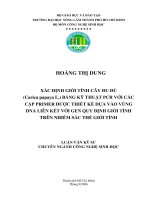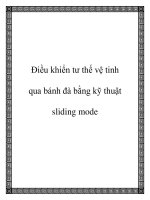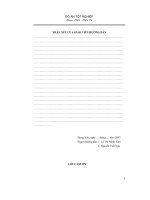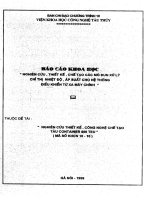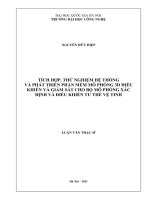Điều khiển tư thế vệ tinh qua bánh đà bằng kỹ thuật sliding mode potx
Bạn đang xem bản rút gọn của tài liệu. Xem và tải ngay bản đầy đủ của tài liệu tại đây (707.35 KB, 8 trang )
Điều khiển tư thế vệ tinh
qua bánh đà bằng kỹ thuật
sliding mode
Điều khiển tư thế vệ tinh qua bánh đà bằng kỹ thuật sliding mode
Sliding mode control for satellite attitude by momentum wheels
Trung-Kien Dao, Chih-Keng Chen
Dept. of Mechanical and Automation Engr., Dayeh University, Changhua, Taiwan
email:
Tóm tắt
Bài báo này trình bày một phương pháp dùng kỹ thuật sliding
mode (điều khiển trượt) để điều khiển tư thế vệ tinh với hai
phiến pin mặt trời có khả năng đàn hồi. Với một vệ tinh di
chuyển theo quỹ đạo quanh Trái Đất, các nhiệm vụ liên lạc
luôn đòi hỏi được cung cấp năng lượng, vì vậy việc điều khiển
cho các phiến pin hướng về phía mặt trời nhiều nhất có thể là
một vấn đề trọng yếu. Trước hết, một mô hình động lực học
của vệ tinh với ba bánh đà và động cơ được xây dựng. Trên
cơ sở đó, một mặt trượt (sliding surface) được định nghĩa để
xây dựng luật điều khiển đảm bảo sai số bám tư thế (gồm ba
góc Euler) luôn giảm. Tính bền vững của bộ điều khiển được
chứng minh qua việc mô phòng trong các điều kiện về ngoại
lực và độ đàn hồi của các phiến pin khác nhau.
Abstract
In this paper, the attitude control of a satellite
with flexible solar panels is investigated by
using sliding mode. The satellite is supposed to
move in a circular orbit around the Earth. Since
communication tasks always require energy, it is
survival that the solar panels orient towards the
Sun as long as possible, so that the panels can
receive the most energy. In the first step, a
dynamics model of the satellite disposed by
three momentum wheels whose angular speeds
controlled by corresponding motors is
developed. On the basis of this model and the
defined sliding surfaces, a control law is derived
in a way such that the tracking errors consisting
of three Euler angles are always decreasing. Robustness of this controller is verified by
simulation in different conditions of external disturbance and flexibility of the panels.
1. Introduction
Consider an autonomous satellite with two solar panels moving in a circular orbit around the Earth. Since communication
tasks always require energy, it is
